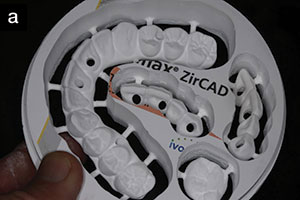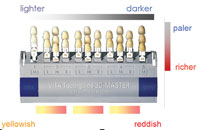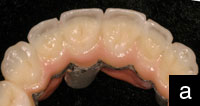An occlusal appliance is a noninvasive, removable, hard acrylic device that fits on the incisal and occlusal surfaces of the teeth.1 The appliance may be referred to as a nightguard, biteguard, splint, or other similar term. Splints may be considered for use as part of various treatments ranging from temporomandibular joint dysfunction to minimizing unfavorable forces on newly fabricated dental prostheses. Okeson1 has outlined that splints can provide an orthopedically stable joint position, introduce an optimal occlusal relationship, encourage normal facial muscle function, and protect the teeth and supporting structures from abnormal forces.
The fact that splints are removable indicates that treatment success solely depends upon patient compliance. A patient who does not wear the appliance will not benefit from the treatment. Patient compliance is largely related to comfort. The more comfortable the appliance, the greater the compliance with and success of the treatment. In addition, the uncomfortable patient constantly seeks adjustments to the appliance to increase its comfort. This can prove frustrating to the clinician and patient, as adjustments may not increase comfort.
BACKGROUND
 |
 |
|
Figure 1. Distal fracture. |
Figure 2. Distal hole due to wear. |
 |
|
Figure 3. Complete fracture. |
Splints are composed of hard, thermoplastic acrylic. Although the material may have minor flexibility under extreme heat (hot water), it is generally rigid. The rigidity of the appliance reduces the comfort, compliance, and treatment success. Moreover, rigid appliances require difficult and time-consuming chairside adjustments. This causes frustration for both the clinician and patient.
Fractures of rigid appliances are common clinically. The fractures tend to occur at the most distal aspect of the appliance (Figure 1). If the material has excessive wear, a small hole can also occur (Figure 2). Eventually, small fractures and holes can progress to a complete fracture of the appliance (Figure 3).
The Impak P.F. appliance (Pow Laboratories) is composed of acrylic, but in a proportion that offers significant thermoplastic flexibility, which serves to increase comfort and patient compliance, improve treatment success, reduce chairside adjustments, and reduce or eliminate fractures. The Impak P.F. appliance can be fabricated to address such conditions as bruxing, clenching, and the need for repositioning of the jaws.
CASE REPORT: METHODS AND MATERIALS
 |
 |
|
Figure 4. Tooth wear from bruxism. |
Figure 5. Maxillary impression. |
 |
 |
|
Figure 6. Mandibular impression. |
Figure 7. Bite registration. |
 |
 |
|
Figure 8. Articulation. |
Figure 9. Impak P.F. appliance. |
 |
 |
|
Figure 10. Appliance at rest. |
Figure 11. Appliance demonstrates flexibility. |
 |
 |
|
Figure 12. Appliance demonstrates further flexibility. |
Figure 13. Appliance— open mouth. |
This article will present a clinical case that reviews the technique for using the Impak P.F. appliance.
A young woman presented with evidence of bruxism. Her parafunctional habit had created a significant wear facet on the lower left first molar and damage to a MODL porcelain onlay (Figure 4). An Impak P.F. appliance was treatment planned. Alginate impressions were taken of the maxilla (Figure 5) and mandible (Figure 6). Alginates must be poured and separated according to manufacturer’s guidelines. Alternatively, the clinician may use a polyvinyl siloxane material with appropriate trays, and these may be sent to the lab to be poured. A registration of the occlusal relationship was taken with Quick Bite (Clinician’s Choice; Figure 7). The impressions were disinfected and poured with standard dental stone in our in-house lab.
The casts and bite registration were sent to Pow Laboratories. The casts were articulated (Figure 8), and an Impak P.F. appliance was fabricated and returned for delivery (Figure 9). Figures 10 to 12 display the flexibility of the Impak P.F. appliance once it has been warmed. The appliance was fitted intraorally (Figure 13) and assessed for fit and comfort. The occlusal relationship of the appliance was then evaluated (Figure 14); adjustments can be made at this time if needed. The occlusal relationship should provide for equal and harmonious bite forces, as indicated by articulating pa-per and patient feedback. (Figure 15).
 |
 |
|
Figure 14. Bite on appliance. |
Figure 15. Appliance articulation. |
The Impak P.F. appliance requires that it soaks in hot tap water for 30 seconds prior to insertion. Following wear, the appliance can be brushed with tap water and stored in a clean, dry container until further use.
DISCUSSION
The Impak P.F. appliance had been prescribed for several of our patients. A survey was recorded following weeks of Impak P.F. appliance therapy. The results indicated that all of the patients found the fit, feel, comfort, and bite (occlusal relationship) of the appliance to be good or excellent. All patients indicated that they were compliant with treatment recommendations. All patients found it better than their old, rigid appliance, and all patients would recommend this appliance
to other patients.
From a clinician’s perspective, the Impak P.F. appliance provided faster delivery time and reduced chairside adjustments. In addition, patients had greater comfort, better compliance, and greater treatment success. Lastly, a fracture of the Impak P.F. appliance has not been noted to date.
CONCLUSION
Occlusal appliances provide several benefits for the dental patient. The Impak P.F. appliance is inexpensive, removable, and noninvasive. The fact that conventional splints are uncomfortable, require frequent adjustments, and tend to fracture hinders their use. The Impak P.F. appliance consists of material in new proportions that address the shortcomings of traditional splints. Consequently, these appliances provide benefits in terms of patient comfort and compliance, treatment success, reduced chairside adjustments, and fewer failures.
Acknowledgment
The author would like to recognize Pow Laboratories for the fabrication of the appliance in this case report.
Reference
1. Okeson JP. Management of Temporomandibular Disorders and Occlusion. 3rd ed. St Louis, Mo: Mosby; 1993:464-492.
Dr. Kalman maintains a private practice in aesthetic and general dentistry in London, Ontario, and is an adjunct professor in the Multidisciplinary Clinic at the Schulich School of Dentistry, University of Western Ontario. He can be reached at (519) 672-3401 or by visiting 4seasonsdental.ca.
Disclosure: The author has no financial interest in Pow Laboratories or the Impak P.F. appliance.











